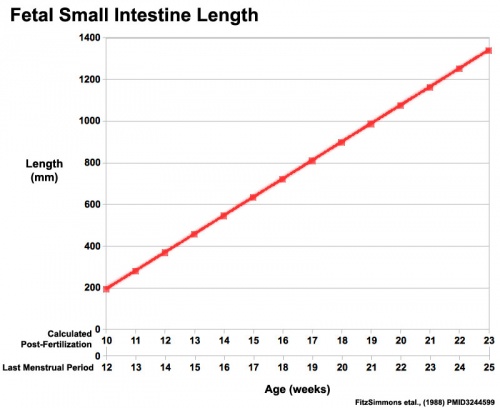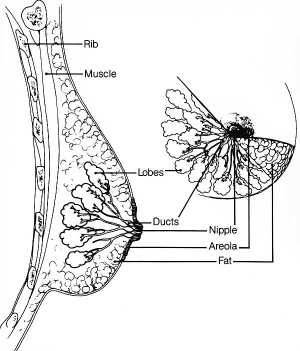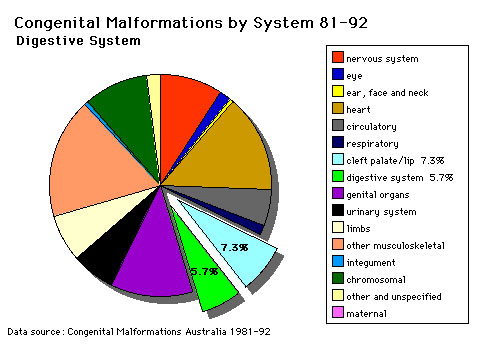BGDB Gastrointestinal - Activity 4
| Practical 1: Activity 1 | Activity 2 | Activity 3 | Activity 4 |
Learning Activity 4
|

Gastroschisis |
1. Fetal and Postnatal Changes
Intestinal Length Growth
Small Intestine length (mm)
Amniotic Fluid Swallowing

|
Volume - increases as the fetus grows.
|
In early embryonic development both the buccopharyngeal and cloacal membranes degenerated, allowing the GIT to be filled with amniotic fluid. Towards the end of the fetal period the fetus is now swallowing approximately 500 ml of amniotic fluid / day.
<html5media width="600" height="400">https://www.youtube.com/embed/r9D7aiFG7N8</html5media>
This swallowed amniotic fluid moves through the GIT from esophagus, to stomach, to small intestine, stopping at the large bowel. In the large bowel the majority of fluid (water) is absorbed, along with electrolytes, glucose, urea and hormones. This process may contribute to fetal nutrition and prepare the GIT for its postnatal function. The process of swallowing amniotic fluid has been suggested to also help regulate fluid volume.
Fetal Meconium
- Mixture of substances (debris, glandular secretions, fatty material and bile pigments) that accumulate in the large bowel (green fecal material).
- Will form the neonatal meconium which is the first (usually within 24h to 48h) postnatal excretion from the GIT.
- If no discharge (bowel motion) is observed in this early period it can be indicative of an abnormality of the GIT.
- The first stool (meconium) is passed within 24 hours in most healthy term infants.
Nutrition - Milk
Breast milk makes us mammals! A review article by Goldman[1] may provide a way of thinking about GIT and human milk.
- "Human milk contains agents that affect the growth, development and functions of the epithelium, immune system or nervous system of the gastrointestinal tract. Some human and animal studies indicate that human milk affects the growth of intestinal villi, the development of intestinal disaccharidases, the permeability of the gastrointestinal tract and resistance to certain inflammatory/immune-mediated diseases. Moreover, one cytokine in human milk, interleukin (IL)-10, protects infant mice genetically deficient in IL-10 against an enterocolitis that resembles necrotizing enterocolitis (NEC) in human premature infants.
There are seven overlapping evolutionary strategies regarding the relationships between the functions of the mammary gland and the infant’s gastrointestinal tract as follows:
- certain immunologic agents in human milk compensate directly for developmental delays in those same agents in the recipient infant
- other agents in human milk do not compensate directly for developmental delays in the production of those same agents, but nevertheless protect the recipient
- agents in human milk enhance functions that are poorly expressed in the recipient
- agents in human milk change the physiologic state of the intestines from one adapted to intrauterine life to one suited to extrauterine life
- some agents in human milk prevent inflammation in the recipient’s gastrointestinal tract
- survival of human milk agents in the gastrointestinal tract is enhanced because of delayed production of pancreatic proteases and gastric acid by newborn infants, antiproteases and inhibitors of gastric acid production in human milk, inherent resistance of some human milk agents to proteolysis, and protective binding of other factors in human milk
- growth factors in human milk aid in establishing a commensal enteric microflora"
(Text from: Goldman ref[1])
- Links: milk
Gut Microorganism Population
The normal newborn gastrointestinal tract contains little if any microorganisms (commensal intestinal microbiota, microbiota, flora, microflora). Postnatally, the tract has to be populated by microorganisms, which are mainly anaerobic bacteria and then aerobic bacteria, but may also include yeast and fungi. The foregut comparatively has few microorganisms when compared to the midgut and hindgut.
Infections
There are several infectious pathogens that can also populate the postnatal gut leading to a number of different diseases:
- Gastroenteritis - (acute infectious enteritis) Occurs in children and is generally viral (rotavirus) rather than bacterial. By 5 years of age, nearly every child worldwide will have had at least one episode of rotavirus gastroenteritis. Note that maternal gastroenteritis during pregnancy can also affect birthweight.
- Escherichia coli (enterotoxigenic)
- Shigella a gram-negative, non-spore forming rod-shaped bacteria infectious through poor hygeine and ingestion, fecal–oral contamination. (More? Dysentery)
- Vibrio cholerae
- Listeria
Antibiotics
Treatment of other neonatal infections systemically with antibiotics can alter the bacterial population.
2. Common Abnormalities
Gastrointestinal Tract Defects of all notifiable birth defects in Australia (1981-1992)
The table below shows the most recent ICD-11 coding for congenital gastrointestinal abnormalities.
| ICD-11 Structural developmental anomalies of the digestive tract |
|---|
|
LB10 Structural developmental anomalies of salivary glands or ducts | LB11 Congenital diverticulum of pharynx | LB12 Structural developmental anomalies of oesophagus | LB13 Structural developmental anomalies of stomach | LB14 Structural developmental anomalies of duodenum | LB15 Structural developmental anomalies of small intestine | LB16 Structural developmental anomalies of large intestine | LB17 Structural developmental anomalies of anal canal | LB18 Congenital anomalies of intestinal fixation | Structural developmental anomalies of the liver, biliary tract, pancreas or spleen | Inborn Errors of Metabolism |
| gastrointestinal abnormalities |
- What is oesophageal atresia (EA) and what are the possible developmental causes?
- What is the most common gastrointestinal motility abnormality of the newborn?
- Which is more common omphalocele or gastroschisis?
3. Gut Diagnostics
Heelprick Test
![]() Guthrie test is a neonatal blood test to detect aa number of different congenital abnormalities, including metabolic disorders.
Guthrie test is a neonatal blood test to detect aa number of different congenital abnormalities, including metabolic disorders.
| Practical 1: Activity 1 | Activity 2 | Activity 3 | Activity 4 |
Additional Information
| Additional Information - Content shown under this heading is not part of the material covered in this class. It is provided for those students who would like to know about some concepts or current research in topics related to the current class page. |
- For more detailed descriptions see gastrointestinal abnormalities.
- Meconium Aspiration - can occur near term or at delivery, if meconiumis discharged into the amiotic fluid (meconium stained amniotic fluid) and then injested by the fetus as it swallows amiotic fluid. Can then lead to meconium aspiration syndrome (MAS), meconium is drawn into the fetal/newborn lungs, causing inflammation, cell death and potentially perinatal death. Meconium can also damage the placenta and associated blood vessels.
- Polyhydramnios - (hydramnios, amniotic fluid disorder) refers to abnormally high amniotic fluid levels.
- Elliott EJ & Dalby-Payne JR. (2004). 2. Acute infectious diarrhoea and dehydration in children. Med. J. Aust. , 181, 565-70. PMID: 15540971
| USA Selected Statistics (2006) | ||||||||||||||||||||||||||||||||||||||||||||||||||||||||||||||||||||||||
|---|---|---|---|---|---|---|---|---|---|---|---|---|---|---|---|---|---|---|---|---|---|---|---|---|---|---|---|---|---|---|---|---|---|---|---|---|---|---|---|---|---|---|---|---|---|---|---|---|---|---|---|---|---|---|---|---|---|---|---|---|---|---|---|---|---|---|---|---|---|---|---|---|
| ||||||||||||||||||||||||||||||||||||||||||||||||||||||||||||||||||||||||
| Gastrointestinal Tract Terms | ||
|---|---|---|
| ||
|
BGDB: Lecture - Gastrointestinal System | Practical - Gastrointestinal System | Lecture - Face and Ear | Practical - Face and Ear | Lecture - Endocrine | Lecture - Sexual Differentiation | Practical - Sexual Differentiation | Tutorial
Glossary Links
- Glossary: A | B | C | D | E | F | G | H | I | J | K | L | M | N | O | P | Q | R | S | T | U | V | W | X | Y | Z | Numbers | Symbols | Term Link
Cite this page: Hill, M.A. (2024, April 28) Embryology BGDB Gastrointestinal - Activity 4. Retrieved from https://embryology.med.unsw.edu.au/embryology/index.php/BGDB_Gastrointestinal_-_Activity_4
- © Dr Mark Hill 2024, UNSW Embryology ISBN: 978 0 7334 2609 4 - UNSW CRICOS Provider Code No. 00098G


